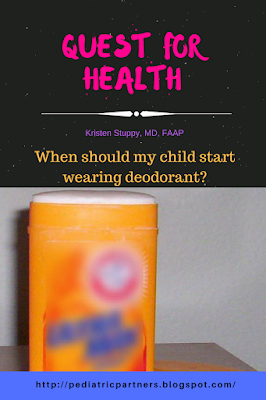There's no standard answer since kids have different needs. Some kids are active outside and simply carry the smells of the great outdoors and sweat on their body. This isn't puberty sweat, just musty body odor in most young smelly children. Sweat in general makes conditions ripe for bacteria to grow on our skin, and the bacteria make us smell. Kids enter puberty at different ages, and puberty affects how we smell in addition to many other obvious things because sweat glands become more active.
 |
| Image source: Wikimedia |
First things first: get clean!
Body odor is often related to bathing, since some early elementary school aged kids shower independently, but don't do the best job at actually using soap in all the areas it's needed. Or they argue about needing to get clean daily. Every other day might work in the winter (if they don't sweat a lot with play) but in the summer, they really need a daily cleansing if they smell offensively.
The first step I always recommend is making sure kids who have that funky smell shower (or take a bath) daily with the same soap that the parents use, not a baby wash. Many families buy baby washes for the first year of life and keep using them during toddlerhood and childhood out of habit. Baby washes don't lather up well (which leads to less body surface areas getting lathered up) and aren't designed to get the oils, dirts, and smells off like regular soaps. There really is no need to continue to use these washes for kids beyond infancy and it might contribute to body odors.
Talk to your kids about getting soap suds on all body parts. I think using a shower pouf with a body wash makes it fun for kids to see all the bubbles - and it helps them to see what parts are done and which need suds. If your child likes to play in the bath tub, it might help for them to end with a quick wash and/or rinse in the shower, since they are sitting in the dirty water during the bath. It is hard to wash the submerged body parts with soap, since the cloth or pouf rinses out under water. They will need to stand to wash the lower half of their body properly.
A note about the poufs: Be sure to show your kids how to rinse the bubbles out of the pouf after the shower or bath and hang it to dry between uses. You'll also want to wash the poufs weekly. I sometimes throw them into the washing machine with the towels, but that takes the life out of them more quickly than soaking in vinegar and water.
Go over all the body parts to wash. I looked for a video that they could sing along to (there are a lot for washing hands and brushing teeth), but couldn't find a good one to remind kids of all the body parts. If anyone's musically talented, this would be a great project to help many kids (and parents)! If you find a good video, please share the link in the comments below!
- Hair - It is tricky for kids to massage all parts of their scalp when washing hair, so show them to use their fingertips up and down then side to side to cover all parts of the head. The frequency of how often hair needs to be washed can be debated. Hair can trap pollen and other outdoor smells and the scalp's sweat can lead to funky odor, so hair needs to be washed at least a couple days per week and daily for those with allergies to pollens that are in the environment at that time.
- Face - Kids won't want to get soap in their eyes so many parents just have them rinse with water, but many kids need to actually wash with a mild soap or cleanser. Eyelids can get what my parents used to call "sleep dust" - little crusties - if they are never washed. You can use a baby "no tears" shampoo to wash eyelashes if needed or a mild soap or cleanser with closed lids and careful rinsing. When kids start getting oily skin on the face they should wash it twice a day. A quick reminder not directly related to cleaning: A daily moisturizer with sunscreen is great all year long for our faces, which are exposed to the sun and elements every day.
- Armpits - While it seems obvious when you've talked to your kids about having smelly pits, you'd be surprised that it doesn't always equate to kids being conscious of washing those pits. With soap. Kids just don't make the connections you think are obvious.
- The whole back - It is hard for any of us to wash our own back, so show your kids how to use a back scrubber or wash cloth to reach all areas.
- Belly, arms, and legs - Again, have them look to see where the suds are and where they're missing to hit all the areas.
- The bottoms of the feet - Show kids how to hold on to something when washing their feet and consider adding a non-slip surface to your shower or tub. Have them wash one at a time so they can stand on the non-soapy foot. Soapy feet are slick!
- Between the legs - Kids need to be taught to wash between the buttocks and around their genitals, with special care given to rinsing these areas well. Trapped soaps can irritate the skin and cause rashes, so rinsing should get special attention in these sensitive areas. I really like removable shower heads that can come down to help rinse, but kids can also use several cups of clean water to rinse hard to reach areas. Girls might need to sit in the tub to do this rinsing with a cup because it's hard to splash the water up between skin folds sufficiently.
Clothing
Kids might have a favorite shirt that they want to wear every day, but clothing (especially shirts, socks, and underwear) must be washed regularly. Putting stinky clothes on a clean kid just makes the kid stinky. Avoid polyester (except the special polyester in performance wear- designed to wick sweat away) and rayon clothes, since they do not absorb the sweat well. Cotton is a great choice: it absorbs sweat well and is relatively inexpensive.
If kids have sweaty feet, white socks might be better than colored ones due to the coloring irritating the feet. Changing socks when the feet get sweaty, such as after playing a sport, can help. Changing shoes and allowing each pair to dry thoroughly between wears can help too.
Deodorant vs Anti-perspirant?
Deodorant is used to cover up smells. It is often what I recommend for those younger kids who sweat during active play or outside in the heat.
Anti-perspirant is designed to decrease sweating and often is mixed with a deodorant. Before puberty a deodorant is probably sufficient, but during puberty our sweat glands are activated and we sweat a lot more, especially under the arms, on hands and feet, and in the groin. It is personal choice if one wants to decrease underarm sweating with an antiperspirant.
Over the years I have seen many concerns with the aluminum in antiperspirants - everything from it causes Alzheimer's to it causes cancer. Studies do not support those claims. You can read more about the proposed risks of antiperspirants on WebMD.
When is sweating abnormal?
Sweating is abnormal if it is excessive for the body's needs or if a child has other signs of puberty before the normal ages (8 years in girls, 10 years in boys- some sources say 7 years in girls and 9 years in boys).
There are many reasons for excessive sweat that are relatively uncommon, so I won't go into detail here. If you think your child sweats excessively or is entering puberty too early, please take him or her to their doctor to be evaluated. (A phone call isn't sufficient because they will need to look for associated signs and symptoms on an exam.)
Next up...
I will cover "When should my child shave?" next, since it is also a very common question!

No comments:
Post a Comment